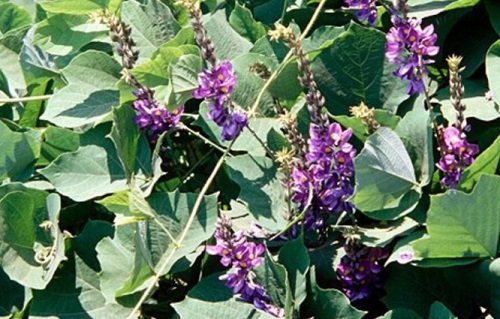Nikhil Prasad Fact checked by:Thailand Medical News Team Nov 09, 2024 6 months, 2 hours, 17 minutes ago
Herbs And Phytochemicals: Osteoarthritis (OA) is a widespread joint disease marked by the breakdown of cartilage, often resulting in joint pain, stiffness, and loss of movement. As people age, the risk of developing OA increases, making it a significant concern, especially in older populations. With limited treatment options beyond managing symptoms, researchers continually seek alternatives that might halt or slow OA’s progression. A recent study has shown that ononin, a phytochemical compound found in plants like kudzu and soy, could have promising effects against OA by influencing inflammation and cartilage breakdown.
 The Kudzu plant from which the phytochemical Ononin is extracted from.
The Kudzu plant from which the phytochemical Ononin is extracted from.
This
Herbs And Phytochemicals news report focuses on ononin’s potential to delay OA’s progression, specifically through its impact on inflammatory pathways that drive cartilage damage. Led by researchers from Guangxi Medical University-China, the People’s Hospital of Guangxi Zhuang Autonomous Region-China, and the Albert Einstein College of Medicine-USA, the study examined ononin's effects on OA in a rat model. Through a range of biological tests and measurements, the research team explored how ononin might provide a new approach to treating OA.
Study Details: Targeting Inflammation in Osteoarthritis
To explore ononin's impact on OA, researchers created a model using rats with anterior cruciate ligament transection (ACLT)-induced OA. Over eight weeks, these OA-afflicted rats were treated with varying doses of ononin. The team closely monitored changes in the cartilage structure and levels of key inflammatory proteins. Tests included enzyme-linked immunosorbent assays (ELISA), histopathology, and immunohistochemistry to assess how ononin altered inflammatory responses and cartilage health.
The study’s findings indicated that ononin helped maintain healthier cartilage structures and reduced markers associated with cartilage damage and inflammation. Specifically, ononin affected two major inflammatory pathways - MAPK and NF-κB, both of which play a significant role in OA’s disease progression. By impacting these pathways, ononin not only reduced inflammatory markers but also helped preserve the integrity of the cartilage matrix, a crucial factor in maintaining joint function.
Key Findings: How Ononin Protects Cartilage
The study provided significant insights into ononin's mechanisms of action in protecting cartilage. Here’s a breakdown of the main findings:
-Reduced Inflammatory Cytokines: One hallmark of OA is an elevated presence of inflammatory cytokines, like IL-1β, TNF-α, and IL-6, which exacerbate joint inflammation and cartilage degradation. The researchers found that ononin lowered these cytokines in a dose-dependent manner, meaning higher doses had a greater impact on reducing these inflammation-driving proteins.
<
strong>-Preserved Cartilage Structure: Through histological staining techniques, the team observed that ononin helped maintain the structure of cartilage in treated rats. Cartilage sections from untreated OA rats showed severe erosion and fragmentation, while those treated with ononin showed less structural damage, maintaining a more intact cartilage matrix.
-Regulation of Cartilage Degrading Enzymes: OA is often associated with high levels of matrix metalloproteinase-13 (MMP-13), an enzyme that degrades the cartilage matrix, especially collagen II. This research demonstrated that ononin decreased MMP-13 levels while increasing collagen II, suggesting that it prevents cartilage breakdown by balancing the enzymes responsible for matrix maintenance and degradation.
-Inhibition of MAPK and NF-κB Pathways: The MAPK and NF-κB pathways are vital signaling pathways that drive inflammatory responses and cartilage damage in OA. Ononin was shown to suppress these pathways by reducing the phosphorylation of proteins like ERK, JNK, and p38 in the MAPK pathway, and p65 in the NF-κB pathway. This suggests that ononin’s anti-inflammatory effects may result from its ability to inhibit these two pathways, preventing the activation of inflammatory responses in cartilage cells.
-Stable Protein Binding Through Molecular Docking: To further understand how ononin interacts with specific proteins in these pathways, researchers used molecular docking analysis. The results showed that ononin binds stably with key proteins in both MAPK and NF-κB pathways, supporting its potential to disrupt these pathways and reduce inflammatory signaling.
Safety Evaluation of Ononin
The research team also looked into the safety profile of ononin to assess its potential for future clinical use. During the eight-week treatment period, rats treated with ononin did not show any significant changes in liver, spleen, or kidney health, as assessed through weight measurements and histopathological examination. Additionally, no substantial differences in body weight or organ coefficients were observed between the ononin-treated and untreated groups, suggesting that ononin has a favorable safety profile, at least in the context of this animal study.
Potential Implications for Osteoarthritis Treatment
Ononin’s effects on OA in this study are promising and could lead to new treatment options. The findings suggest that ononin not only mitigates cartilage degradation but also reduces inflammation, both of which are central to OA progression. By inhibiting the MAPK and NF-κB pathways, ononin appears to disrupt the cycle of inflammation and tissue degradation that typically worsens OA over time. This dual action makes ononin a compelling candidate for further study and potentially a new option for OA management, offering a natural alternative that could reduce the reliance on NSAIDs, which often carry risks of side effects.
Conclusion
In conclusion, ononin shows great promise as a potential OA treatment, particularly because of its ability to target both inflammation and cartilage degradation. By modulating the MAPK and NF-κB pathways, ononin may offer a way to slow or prevent joint damage in OA, thus preserving joint function and potentially improving quality of life for those affected by this chronic condition. However, as with all preclinical studies, further research is necessary to validate these results in human trials. This study provides an essential step forward in understanding how plant-based compounds like ononin might contribute to managing and possibly delaying OA progression.
The study findings were published in the peer-reviewed journal: PLOS ONE.
https://journals.plos.org/plosone/article?id=10.1371/journal.pone.0310293
For the latest on
Herbs and Phytochemicals, keep on logging to Thailand Medical News.
Read Also:
https://www.thailandmedical.news/news/new-hope-for-treating-sars-cov-2-virus-induced-osteoarthritis
https://www.thailandmedical.news/news/herbs-phytochemicals-celastrol-from-tripterygium-wilfordii-inhibits-rheumatoid-arthritis-progression-by-targeting-the-commd3-8-complex
